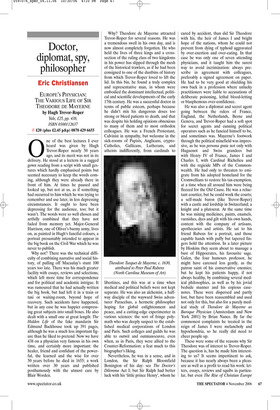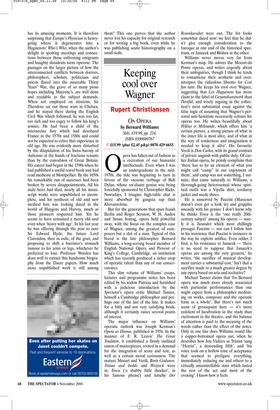Doctor, diplomat, spy, philosopher
Eric Christiansen
EUROPE’S PHYSICIAN: THE VARIOUS LIFE OF SIR THEODORE DE MAYERNE by Hugh Trevor-Roper Yale, £25, pp. 438, ISBN 0300112637 ✆ £20 (plus £2.45 p&p) 0870 429 6655 One of the best lectures I ever heard was given by Hugh Trevor-Roper nearly 50 years ago, and its merit was not in its delivery. He stood at a lectern in a ragged gown reading from a script with small gestures which hardly emphasised points but seemed necessary to keep the words coming, although they were already there in front of him. At times he paused and looked up, but not at us, as if something had occurred to him which he was trying to remember and use later, in less depressing circumstances. It ought to have been depressing for the audience, too; but it wasn’t. The words were so well chosen and artfully combined that they have not faded from memory yet. Major-General Harrison, one of Oliver’s barmy army, lives on, as painted in Hugh’s fanciful colours, a portrait presumably intended to appear in the big book on the Civil War which he was never to publish.
Why not? There was the technical diffi culty of combining narrative and social history, of pulling off Macaulay’s stunt 100 years too late. There was his much greater facility with essays, reviews and selections, which left more time for correspondence and for political and academic intrigue. It was rumoured that he had actually written the big book, but had left it in a train or taxi or waiting-room, beyond hope of recovery. Such accidents have happened, but in any case he was happier compressing great subjects into small boxes. He also dealt with a small one at great length: The Hidden Life of the fake mandarin Sir Edmund Backhouse took up 391 pages, although he was a much less important figure than he liked to pretend. Now we have 438 on a physician very famous in his own time, and certainly more important: the healer, friend and confidant of the powerful, the learned and the wise for over 50 years before he died in 1655; a work written over 30 years and published posthumously with the utmost care by Blair Worden. Why? Theodore de Mayerne attracted Trevor-Roper for several reasons. He was a tremendous swell in his own day, and is now almost completely forgotten. He who held the lives of three kings and a crosssection of the ruling class of two kingdoms in his power has slipped through the mesh of the historical trawlers, as if he had been consigned to one of the dustbins of history from which Trevor-Roper loved to lift the lid. In this bin, he found a truly complex and representative man, in whom were embodied the dominant intellectual, political and scientific developments of the early 17th century. He was a successful doctor in terms of public esteem, perhaps because he didn’t mix his dangerous doses too strong or bleed patients to death, and that was despite his holding opinions obnoxious to many of them and to most orthodox colleagues. He was a French Protestant, Calvinist in sympathy, but welcome in the sick-rooms of Papists, Anglicans, cryptoCatholics, Gallicans, Lutherans, and atheists indifferently, from cardinals to libertines, and this was at a time when medical and political beliefs were not kept separate. He was also an alchemist, a halfway disciple of the wayward Swiss adventurer Paracelsus, a hermetic philosopher hoping for global enlightenment and peace, and a cutting-edge experimenter in various sciences: the sort of fringe polymath who was deeply suspect to the established medical corporations of London and Paris. Such colleges and guilds he was able to outwit and outmanoeuvre, even when, as in Paris, they were allied to the Counter-Reformation: a feat much to this biographer’s liking.
Nevertheless, he was in a sense, and in London, the Sir Ralph Bloomfield Bonington of his day: see The Doctor’s Dilemma Act I; but Sir Ralph had better luck with his ‘little prince Henry’, whom he cured by accident, than did Sir Theodore with his, the heir of James I and bright hope of the nations, whom he could not prevent from dying of typhoid aggravated by over-exertion and over-eating. In that case he was only one of seven attending physicians, and it taught him the surest way to avoid incrimination: always prescribe in agreement with colleagues, preferably a signed agreement on paper. He had to be very good at shielding his own back in a profession where unlucky practitioners were liable to accusations of deliberate poisoning, lethal blood-letting or blasphemous over-confidence.
He was also a diplomat and secret agent going between the rulers of France, England, the Netherlands, Berne and Geneva, and Trevor-Roper had a soft spot for secret agents and cunning political operators such as he fancied himself to be, and sometimes was. Mayerne’s footwork through the political minefield was impressive, as he was persona grata not only with Huguenot and Swiss grandees but with Henry IV of France, James I and Charles I, with Cardinal Richelieu and with the regicide MPs of the Commonwealth. He had only to threaten to emigrate from his adopted homeland for the Cromwellians to restore his tax-exemption, at a time when all around him were being fleeced for the Old Cause. He was a reluctant courtier, but he could work the courts; a self-made baron (like Trevor-Roper) with a castle and lordship in Switzerland; a knight and a plutocrat. At the same time he was mixing medicines, paints, enamels, varnishes, dyes and gilt with his own hands, content with the company of artisans, apothecaries and artists. He sat to his friend Rubens for a portrait, and those capable hands with puffy but tapered fingers hold the attention. In a later picture by Hoskins they seem about to massage a bust of Hippocrates, his favourite sage. Galen, the four humours professor, he might have caressed less gently, as the patron saint of his conservative enemies; but he kept his patients happy, if not always healthy, by combining several medical philosophies, as well as by his jovial bedside manner and his copious casenotes. These were dispersed and partly lost, but have been reassembled and used not only for this, but also for a purely medical study of Theodore de Mayerne as Baroque Physician (Amsterdam and New York 2001) by Brian Nance. By far the commonest complaints he treated in the reign of James I were melancholy and hypochondria, so he really did need to cheer people up.
These were some of the reasons why Sir Theodore was of interest to Trevor-Roper. The question is, has he made him interesting to us? It seems impertinent to ask, because it has nearly always been a pleasure as well as a profit to read his work: letters, essays, reviews and squibs in particular, but even The Rise of Christian Europe has its amusing moments. It is therefore surprising that Europe’s Physician is heavygoing where it degenerates into a Huguenots’ Who’s Who; when the author’s delight in spotting meetings and connections between those enlivening emigrants and haughty dissidents turns operose. The passages on the larger picture of how the interconnected conflicts between doctors, philosophers, scholars, politicians and priests flared into the miserable Thirty Years’ War, the grave of so many pious hopes including Mayerne’s, are well done and readable as the subject demands. When not employed on missions, Sir Theodore sat out those wars in Chelsea, and he stayed there during the English Civil War which followed; he was too fat, too rich and too cagey to follow his king’s armies. He had been a child of the internecine fury which had desolated France in the 1570s and 1580s and could not be expected to relive that experience in old age. He was evidently more disturbed by the dilapidation of his Swiss barony of Aubonne at the hands of fractious tenants than by the convulsion of Great Britain. His career had begun in the 1590s when he had published a useful travel book and had read medicine at Montpellier. By the 1650s his remarkable run of successes had been broken by severe disappointments. All his male heirs had died, nearly all his manuscript works were unpublished or incomplete, and his synthesis of old and new medical lore was looking dated in the world of Huygens and Harvey, much as those pioneers respected him. Yet he seems to have remained a merry old soul even when ‘heavy with age’. In his last year he was offering through the post to cure Sir Edward Hyde, the future Lord Clarendon, then in exile, of the gout, and proposing to shift a barrister’s stomach tumour to his arms or legs, whichever he preferred to lose. Professor Worden has done well to extract this handsome biography from the Dacre papers. How much more unpublished work is still among them? This one proves that the author never lost his capacity for original research or for writing a big book, even while he was publishing acute historiography on a small scale.



















































































































 Previous page
Previous page